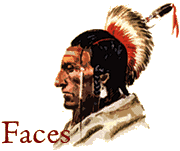

THE BLACKFOOT INDIANS ARE A TRIBE THAT LIVED IN THE NORTHWEST PLAINS. THEY PUSHED TOWARDS THE ROCKY MOUNTAINS AND MISSOURI RIVER. BY THE MIDDLE OF THE 19TH CENTURY THE BLACKFOOT INDIANS HAD CLAIMED A VAST TERRITORY THAT WAS TWICE THE SIZE OF NEW ENGLAND.
THEY WERE AT THE PEAK OF THEIR POWER. WHITE TRADERS AND NEIGHBORING INDIANS SAID THAT THE BLACKFOOT INDIANS WERE THE MOST POWERFUL AND AGGRESSIVE WORRIORS OF THE NORTHWEST PLAINS.
The Blackfoot were placed on four different reservations. The Blackfoot Agency, the Blood Agency, and the Piegan Agency are all located in Alberta, Canada. One of the Blackfoot Reservation in Montana is inhabited by Piegans.
Mooney accepts the estimate of Mackenzie that in 1790 there were approximately9,000
Blackfoot. According to Ewers, however, in 1832 Catlin estimated
that the Blackfoot numbered 16,500, and in 1833 Prince Maximilian
gave an estimate of 18,000 to 20,000.
During the nineteenth century, there were repeated epidemics of smallpox
and measles, which, together with starvation, decimated the population,
so that in 1909 they numbered only 4,635. The Piegans at Blackfoot Reservation
in Montana constituted almost half of this number, with 2,195.
Although Mooney refers to the three groups as a confederacy, there
was no political structure which
would warrant such a term. The only times they gathered together were for
ceremonial purposes.
The Blackfoot were typical of the Plains Indians in many aspects of
their culture. They were nomadic
hunter-gatherers, who lived in tipis.
They subsisted mainly on buffalo
and large mammals and, in addition,
gathered a lot of vegetable foods.
Traditions indicate that the buffalo
were hunted in drives, although
hunting patterns changed when horses
and guns were introduced. Deer
and smaller game were caught with snares.
During the summer, the Blackfoot lived in large tribal camps. It was
during this season that they hunted
buffalos and engaged in ceremonialism,
such as the Sun Dance.
According to Hanks and Richardson the kinship and social
systems were characterized by "anarchistic
individualism." They describe
the kinship system as "multilineal"
and "multilocal," and they speak
in terms of a balance of lines
with a very slight tendency toward
patrilineality. The most basic
social unit was the "orientation group,"
which consisted of the household
of ego's parents and ego's household
as an adult with a family. Polygyny
was practiced and, in fact, was
the general rule.
Band membership was quite fluid. There might be several headmen in
each band, and one of them was
considered the chief. Headmanship was
very informal. The qualifications
for the office were wealth, success
in war, and ceremonial experience.
According to Hanks and Richardson
(1945: 3), authority within the
band was similar to the relationship
between landlord and tenant. As
long as the headman continued to provide
benefits, people remained with
him. But if his generosity should slacken,
people would simply pack up and
move.
The religious life of the Blackfoot centered upon medicine bundles
and their associated rituals. These
bundles were individually owned
and ultimately originated from
an encounter with a supernatural spirit.
These encounters took the form
of dreams or visions, which were sought
in a typical Plains type of vision
quest. A young man, often under
the tutelage of an older medicine
man, would go out to some lonely
place and fast until he had a vision.
Many of these men failed and
never had a vision. In this case,
they would buy a bundle and its
ritual.
Since the Sun Dance was not mentioned by the eighteenth-century explorers,Ewers
feels that it was an early nineteenth-century innovation among
the Blackfoot . By the middle of
the nineteenth century, the Sun Dance had become an important ceremony
performed once each summer. The Sun Dance among the Blackfoot was generally
similar to the ceremony that was performed in other Plains societies. There
were some differences, in that a woman played the leading role among the
Blackfoot, and the symbolism and paraphernalia  used
were derived from beaver bundle ceremonialism. The Blackfoot Sun Dance
included the following: (1) moving the camp on four successive days; (2)
on the fifth day, building the medicine lodge, transferring bundles to
the
used
were derived from beaver bundle ceremonialism. The Blackfoot Sun Dance
included the following: (1) moving the camp on four successive days; (2)
on the fifth day, building the medicine lodge, transferring bundles to
the
medicine woman, and the offering
of gifts by children and adults in
ill health; (3) on the sixth day,
dancing toward the sun, blowing
eagle-bone whistles, and self-torture;
and (4) on the remaining four
days, performing various ceremonies
of the men's societies.
|Iroquois
Basic| homes| Cherokee|
Seminoles| Senecas|
Blackfoot| Onondaga|
Aztec| Iroquois|
table
of contents